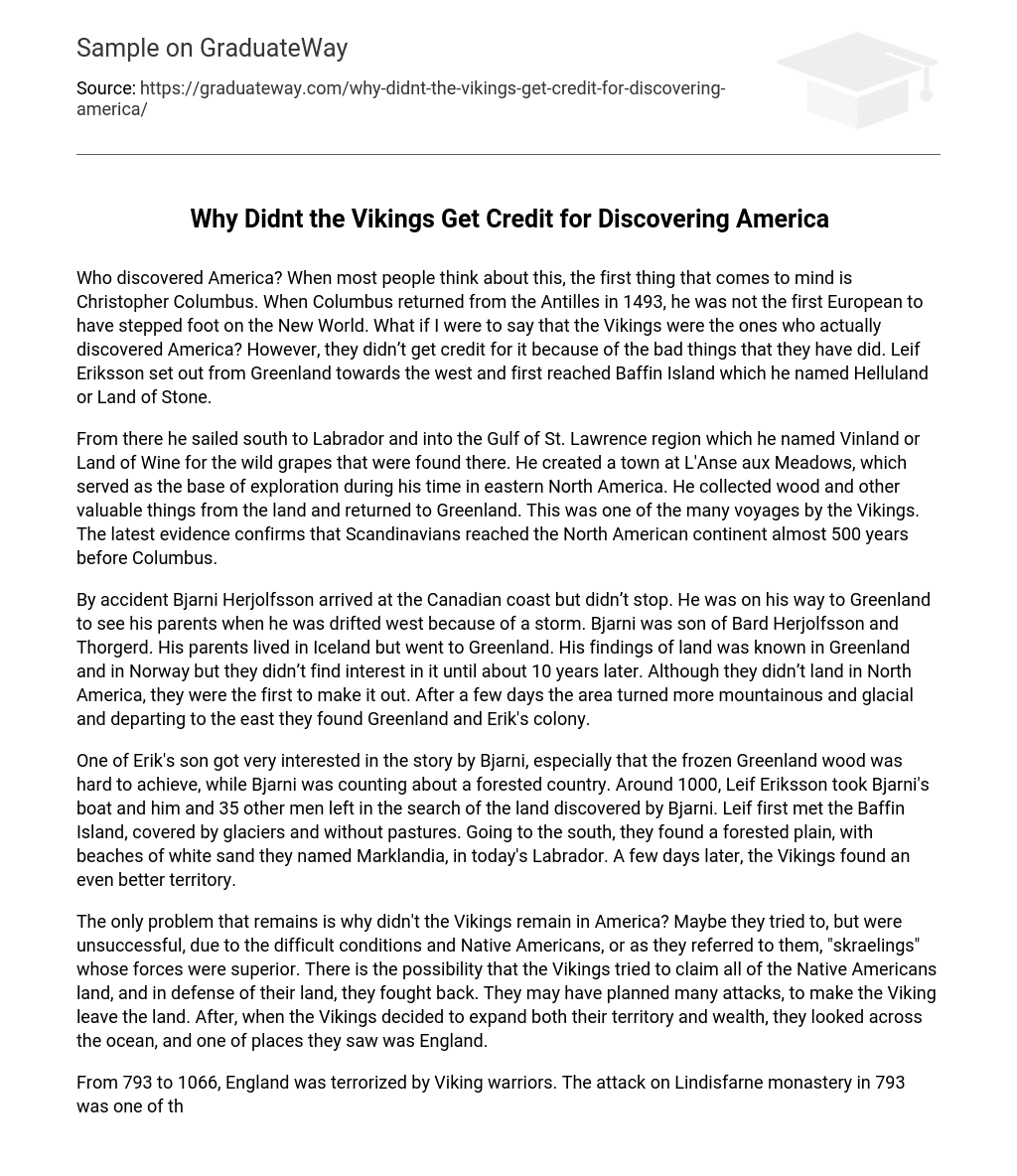While Christopher Columbus is often linked to the discovery of America, it was actually the Vikings who were the initial European explorers to reach the New World. When Christopher Columbus came back from the Antilles in 1493, it became evident that he was not the original discoverer. To everyone’s surprise, Leif Eriksson and his Viking companions can be acknowledged for this accomplishment. Unfortunately, their acknowledgement was overshadowed by negative deeds ascribed to them. Leif Eriksson departed from Greenland heading westward and eventually reached Baffin Island, which he named Helluland or Land of Stone.
From there, he sailed south to Labrador and entered the Gulf of St. Lawrence region, which he called Vinland or Land of Wine due to the presence of wild grapes. He established a town at L’Anse aux Meadows, serving as his base for exploration in eastern North America. He gathered wood and other valuable resources from the land before returning to Greenland. This was just one of the numerous expeditions conducted by the Vikings. The most recent evidence affirms that Scandinavians reached the North American continent nearly 500 years before Columbus.
Bjarni Herjolfsson unintentionally sailed westward due to a storm while on his way to Greenland, where his parents had relocated. Bjarni, the son of Bard Herjolfsson and Thorgerd, was originally from Iceland. The news of his accidental discovery of land spread to both Greenland and Norway, but it did not generate much interest until approximately a decade later. Even though they did not actually make landfall in North America, they were the first individuals to come across it. As they journeyed eastward, they encountered increasingly mountainous and icy terrain until finally reaching Erik’s settlement in Greenland.
One of Erik’s sons became very intrigued by Bjarni’s story, particularly the challenge of obtaining frozen Greenland wood, while Bjarni spoke of a forested country. Around 1000, Leif Eriksson borrowed Bjarni’s boat and, along with 35 other men, set out to search for the land that Bjarni had discovered. Initially, Leif encountered Baffin Island, which was covered in glaciers and lacked pastures. Continuing southward, they discovered a forested plain with white sandy beaches that they named Marklandia, present-day Labrador. A few days later, the Vikings stumbled upon an even more promising territory.
Despite the Vikings’ attempts to settle in America, they were unable to due to the challenging conditions and the Native Americans, whom they called “skraelings,” having stronger forces. Additionally, the Vikings may have provoked conflict by trying to claim the Native Americans’ land, leading to retaliatory attacks. As a result, the Vikings set their sights on England as they sought to expand their territory and wealth.
From 793 to 1066, England experienced a frightening era of Viking invasions that primarily targeted coastal communities. Churches and monasteries were often their chosen victims due to their wealth. The onslaught began with the attack on Lindisfarne monastery in 793, and as war-bands joined forces and pursued political goals, the raids became more fierce. The element of surprise added to the devastation caused by these attacks, as no one could anticipate the Vikings’ next target or method of strike.
The Viking ships possessed a broad hull which allowed them to easily land on sandy beaches sans the necessity of a harbor or pier. This provided them with the advantage of being able to disembark in any location, including those that would pose challenges for an attack. In 793, they initiated their first raid on Lindisfarne, an English church. Subsequently, in 865, the Great Heathen Army launched an assault on East Anglia in England but did not succeed. The Vikings made another endeavor at the battle of Stamford Bridge in 1066; however, it culminated in defeat. During Canute the Great’s reign in 1066, the Vikings once again assaulted England; nevertheless, within the same year, England was effectively conquered by the Normans.
Despite their inability to conquer Paris, the Vikings managed to leave a lasting impression on the King, who rewarded them with land. I am convinced that the Vikings were indeed the original discoverers of America. What sets them apart is the concept of “discovery,” as opposed to the indigenous Americans who inhabited the land. Furthermore, the Vikings had a simplistic naming approach as evident in their choice to call the newly found land “Newfound Land.” It wouldn’t be named as such if it was already occupied. Unfortunately, their actions, such as attacking England, overshadow their contributions and prevent them from receiving recognition.
Why should we give credit to the disliked countries for discovering America? If I were in England’s shoes, I would try to erase them from history. Instead, let’s attribute the credit to someone else from Europe. Both England and Scandinavia are in Europe, so why tarnish Europe’s reputation? Why not let someone from Europe, sent by the king and queen of Spain, receive the credit? This way, we can make people forget about the Vikings and still highlight Europe’s greatness. Shirah Vargas 10/3/09





